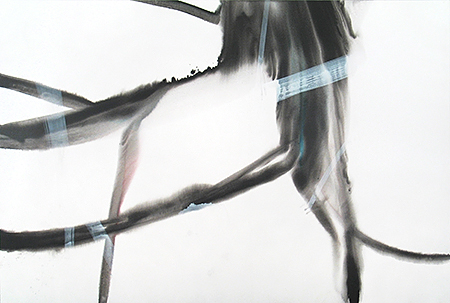The Poetics of Fluid Structures
by Tatiana Ferraz
(translated from Portuguese by Beatriz Viégas-Faria)
Published in the catalogue of the solo exhibition at the Espaço Virgílio, São Paulo SP, 2002.
In the contemporary environment of the realm of visual arts, painting stands out as a major challenge in terms of pictorial language, given its eternal pursuit of an action which may both surprise and innovate. Manoel Veiga is a good example of this journey into incessant poetic research of the condensation of a world made dense and intriguingly presented.
The artist has been developing his own personal way of painting for over seven years, having arrived at a most particular pictorial investigation. In his last series, which he started working on in 2001, the action of the brushstrokes is looser and, at the same time, more assertive, revealing a state of full awareness of the matter, leaving its poetics free to flow and conquer a softness previously veiled.
Veiga’s thoughts and manifestations, originating from his prior experience in the field of engineering and, above all, from his studies of quantum theory, put themselves as a presence on the canvases, as if they were bodies in a continuous action of integration and disintegration. It is movement that refers to the time-following action of Nature, close to dynamic structures and potentialized random systems.
While at the beginning of Veiga’s career his workmanship followed an ever-increasing density of layers in a pictorial ensemble that could be seen as reserved, now the artist arrives at a more decisive stage with fewer brushstrokes and more diluted layers of paint, well dosed as they are with the audacity of one who knows he’s in complete control of the matter he works with – something observable in how the paint covers the canvas, in how spaces are presented in between the stains, and also in how brushstrokes and gestures meet and dissolve in moments of absolute integration.
The canvases have grown larger and wider, with broader intervals within the construction of the space, providing the stains with a breathing movement, in a gesture which is essentially fluid. The colors are no longer mixed in an exhaustive addition of layers over layers of paint, as in previous series, in a centripetal direction. Now the painter prepares a previous mixture, one that will be manifested as such only in the very act of painting, revealing its hues when it accommodates to the canvas. Surprises of color are constructed with time.
The very instability of the tonal mixtures and of the stains reveal the influence of Veiga’s having sudied quantum theory: the principle of uncertainty makes his painting be, at the same time, an enigma and a surprise. All that is veiled by a thin layer of white, a subtle construction that makes a counterpoint to the emblematic character of the protagonist here: color.


Index
Essays
Index
Essays